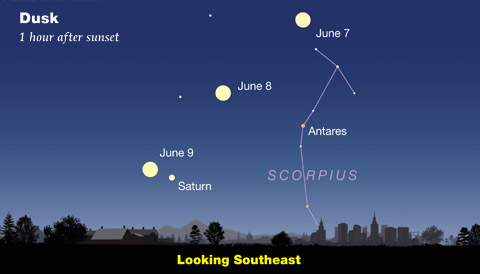June's astronomy podcast takes you on a star- and planet-studded tour of the sky you'll see after sunset.
It's time again for very long days and far-too-short nights! This month’s solstice occurs on the 21st at 12:24 a.m. EDT. Astronomically speaking, that’s when summer begins in the Northern Hemisphere and winter in the Southern Hemisphere. Locations at 40° north will have 15 hours of full daylight.
Two bright planets dominate the evening sky. Look toward south, and you’ll spot Jupiter about halfway from the horizon to overhead. To its lower left, separated by the width of your clenched fist held at arm’s length, is Spica, a star that’s obvious but only about a tenth as bright as Jupiter.

Sky & Telescope
Meanwhile, over in the southeast, another bright planet is making its entrance. That would be Saturn, which stands in opposition to the Sun on June 14th. On that date it rises at sunset and sets at sunrise. To Saturn's upper right is Antares, the red-tinged heart of the constellation Scorpius.
These two planets serve as a easy-to-find guideposts for locating other stars and constellations. To learn more, listen to or download our monthly astronomy podcast below. It provides a 6½-minute-long tour of the stars and planets that you'll see this month.
Podcast: Play in new window | Download
Subscribe: Apple Podcasts | Google Podcasts | Spotify | Email | RSS | More
 1
1
Comments
Capella80
June 8, 2017 at 12:37 am
Yay, I was mentioned! (Sorta...)
You must be logged in to post a comment.
You must be logged in to post a comment.